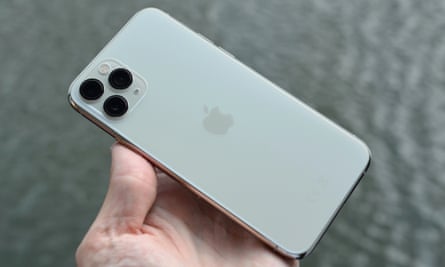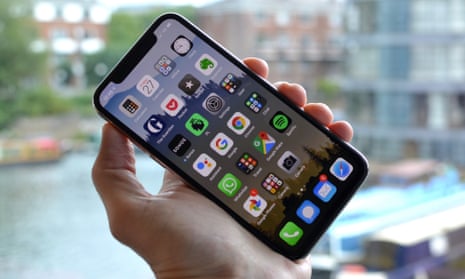Apple’s iPhone has gone “pro” for its 11th iteration, with dramatically improved cameras and longer battery life, which make the smaller iPhone 11 Pro the king of more manageable phones.
The Guardian’s product and service reviews are independent and are in no way influenced by any advertiser or commercial initiative. We will earn a commission from the retailer if you buy something through an affiliate link. Learn more.
Costing from £1,049 the iPhone 11 Pro is one of a rare breed: a premium flagship smartphone that doesn’t have a ginormous screen and is therefore small by today’s standards.
Everything is relative, of course. The iPhone 11 Pro’s 5.8in screen is considerably larger than the 4in iPhone SE, but compared with the monsters of the modern smartphone era with their 6.5in-plus screens the iPhone 11 Pro is positively pocketable.
Going Pro

The iPhone 11 Pro is essentially the same on the outside as the mould-breaking iPhone X from 2017, with a stainless steel and glass body, Face ID notch and 5.8in screen.
The new phone is 0.4mm taller, 0.5mm wider, 0.4mm thicker and 11g heavier than the iPhone XS that came before it, but you’d be very hard pressed to tell, even side-by-side. While the 188g weight is fairly heavy compared with rivals, the rest of the dimensions compare favourably, making the iPhone 11 Pro one of the easiest of devices to pocket, hold and use with one hand.
Apple’s Super Retina XDR “Pro level” OLED screen is new for this year and is considerably brighter during regular usage and when displaying Dolby Vision or HDR10 content.
It’s a gorgeous display. Sharp, bright, colour-rich and full of contrast. At 60Hz it isn’t quite as smooth a screen as the 90Hz display on the OnePlus 7 Pro, but it wins on all other counts against everything else, particularly at this size.
Flip the phone over and you will see a new frosted glass back, which is more grippy when the phone and your hands are cold, but less so than the previous glossy coating when both are warm. The camera lump is now a square raised glass section in the top right with three cameras arranged in a triangle. If you suffer from trypophobia (that’s an aversion to clusters of small holes) the iPhone 11 Pro is definitely not for you.
Specifications
Screen: 5.8in Super Retina XDR (OLED) (458ppi)
Processor: Apple A13 Bionic
RAM: 4GB of RAM
Storage: 64, 256 or 512GB
Operating system: iOS 13
Camera: Triple 12MP rear cameras with OIS, 12MP front-facing camera
Connectivity: LTE, wifi 6, NFC, Bluetooth 5, Lightning, Ultra Wideband and GPS
Dimensions: 144 x 71.4 x 8.1 mm
Weight: 188g
A13 Bionic
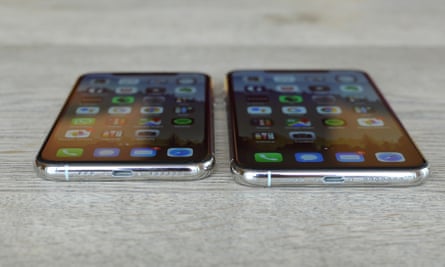
The iPhone 11 Pro has the same A13 Bionic chip, 4GB of RAM and at least 64GB of storage as the rest of the iPhone 11 line, and performs similarly. Everything happens promptly, including intensive tasks such as video editing and gaming.
The iPhone 11 Pro will handle everything you need now, and will likely be a top performer for years to come. There are two small disappointments, however. Despite being “Pro” the new phone still uses the old Lightning connector for charging, not the much more powerful and adaptable USB-C to which Apple switched all its MacBook laptops and the recent iPad Pro.
The starting storage of 64GB is also disappointing. For anyone shooting any amount of 4K video you’ll very quickly fill 64GB, and even if you’re not a “pro” creative, then apps, games and movies will make short work of the space.
Apple says that it’s managed to make the iPhone 11 Pro last four hours longer between charges than the iPhone XS, which only just managed 24 hours in my testing – which itself was worse than the iPhone X at 30 hours.
I’m pleased to report that the iPhone 11 Pro beats Apple’s estimates and lasts eight hours longer than the iPhone XS, at just shy of 32 hours. It will get me from 7am on day one until almost 4pm on day two. Attaching an Apple Watch Series 5 made negligible difference to the battery life of the iPhone too.
That was after the iOS 13.1.2 update, while using it as my primary device without a smartwatch attached, sending and receiving 150 emails and messages, 80 push notifications, listening to five hours of music on Bluetooth headphones, watching an hour of Netflix, and shooting about 10 photos a day.
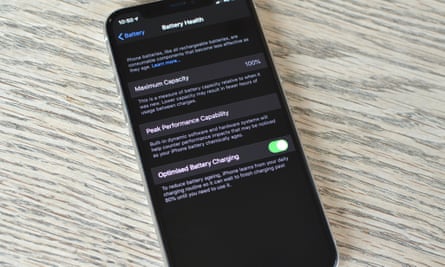
The iPhone 11 Pro is the first Apple smartphone to ship with an 18W USB-C fast charger and a USB-C to Lightning cable in the box. A full charge from flat took just over two hours 10 minutes, but a 50% charge was reached in 28 minutes and 70% in 43 minutes. As with the iPhone 11, Apple is clearly slowing charging to a trickle above 95%, meaning that charging much beyond 90% unless you need it probably isn’t worth it.
The phone also gets pretty hot when fast charging. It can wirelessly charge too, but can’t charge other devices.
It’s also worth noting that iOS 13 includes a battery optimising feature, which is designed to learn your habits and only charge the battery past 80% when it thinks you need it to extend its longevity.
iOS 13.1.2

The iPhone 11 Pro shipped with iOS 13 but was quickly updated three times to iOS 13.1.2, following the same issues suffered with the iPhone 11.
The big new features for iOS 13 are dark mode, which switches the interface a predominately black or dark background with white text. Dark mode theoretically has a battery benefit for the iPhone 11 Pro thanks to the OLED screen, which only consumes electricity for pixels that aren’t black, making white text on a predominantly black background more power efficient than black on white. But you’ll only see a meaningful benefit if the background is truly black and not a dark shade of grey.
Other highlights include the ability to swipe-type on the default keyboard, a long-press on control centre buttons now opens up quick connect menus for Bluetooth or wifi, as well as quickly jumping to the settings app. Photos now has an improved view of all your photos. You can silence unknown and spam callers, while location permissions for apps have been improved and there’s menstrual cycle and headphone audio level tracking in the Health app, which also now has a new more useful summary view.
Apple leads the industry in software updates, providing at least five years of support from release, where other manufacturers cap out at about three years, and has recently shown a surprising ability to rapidly push out bug-fix updates in quick succession.
Camera
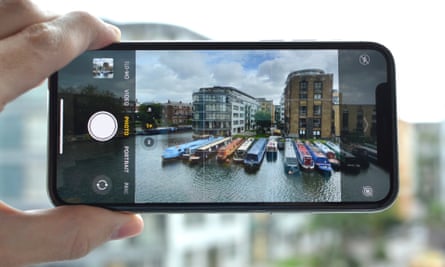
The iPhone 11 Pro has Apple’s first triple 12-megapixel camera setup. It has the same normal and 2x telephoto configuration as previous models, but adds the new ultrawide camera from the iPhone 11.
The combination gives you the ability to shoot at 0.5x, 1x or 2x optical zoom then up to 10x digital zoom.
Apple calls this a “pro camera system” and like the dual-camera system fitted to the iPhone 11, it is a noticeable step up from last year, producing some of the best images I’ve had the pleasure to shoot across a range of different lighting conditions.
Apple’s new night mode brings the iPhone 11 Pro up to par with the gold-standard of Google’s Pixel 3 in very low-light photography, but note that it only operates on the main camera not the ultrawide or telephoto.
The automatic mode takes multiple frames between one and three seconds when handheld, depending on available light and how much you’re shaking the phone. Stick it on a tripod and you can set it to up to 30 seconds, which is best illustrated with starry sky shots - something I couldn’t test in dank, rainy Britain.
Smart HDR has been improved in bright lighting conditions too, producing well controlled highlights with detail in both shadow and bright spots. Images are slightly less flat and more dramatic than the XS last year too, which is a good thing.
The deep fusion technology, which will be enabled on the iPhone 11 series with iOS 13.2 (tested in beta for this review), also made a huge difference in fine detail particularly in middling light. For the first time with any smartphone, including the Pixel 3, we’re approaching the level of sharpness and clarity at full crop that only a proper camera with a large lens has managed in the past.

Video capture from the rear camera is fantastic, arguably the best in the business, including 4K at 60 frames per second. With a third-party app you can also shoot from more than one of the cameras at once, which might be useful for filmmakers, but I can’t ever see myself needing to do that.
The selfie camera is also improved, bumped to 12-megapixels and capable of capturing an almost terrifying level of detail in good lighting. The front-facing camera can also do slow motion selfies, which kids and big kids will love.
Overall the camera on the iPhone 11 Pro is a big step up, levelling to or exceeding rivals from the first half of 2019 in the most important features.
Observations
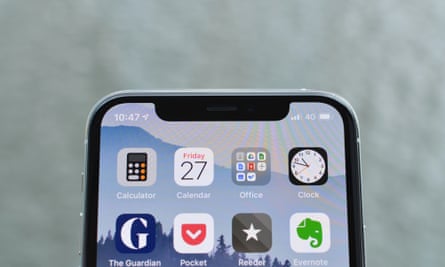
The iPhone 11 Pro is water resistant to IP68 standards of up to 4 metres for 30 minutes, which is 2 metres deeper than last year’s iPhone XS
Bluetooth performance is much improved, with stronger connections to even the weakest of headphones
Face ID is still best-in-class, now slightly faster and working at slightly wider angles
The new U1 chip enables enhanced location abilities, but so far it’s used only for directional AirDrop file sharing
The highly polished stainless steel is easy to mark and dull after even careful general use
The pressure sensitive screen of previous iPhones is gone and with it 3D Touch, so you can’t press harder on things anymore
Price
The iPhone 11 Pro costs £1,049 for 64GB of storage, £1,199 for 256GB or £1,399 for 512GB in black, green, silver or gold.
For comparison, the iPhone 11 Pro Max costs £1,149, the iPhone 11 costs £729, the iPhone XR costs £629, the OnePlus 7 costs £499, the Samsung Galaxy S10 costs £799 and the Huawei P30 Pro costs £799.
Verdict
After a misstep last year, Apple is back on top with what is simply the best smaller phone available. The iPhone 11 Pro has longer battery life, a better screen and excellent performance all round.
The camera is also a big improvement in terms of clarity and performance, particularly in fine detail and very low light, with the added night mode now matching rivals. It won’t yet replace a digital SLR for my professional photography, but it’s closer than anything there has been before.
The design is still a winner at this size, but is starting to look a little dated three years on from the mould-breaking iPhone X. And there’s no 5G to be seen either, when we’re right on the cusp of it being a key differentiator for 2020.
It’s not perfect, but in the sea of ever-larger, hand-stretching phones, it’s refreshing to have a model that’s comparatively easy to pocket, hold and use one-handed that doesn’t compromise on power or features.
The biggest issue with the iPhone 11 Pro is its price. The starting cost of £1,049 comes with only 64GB of storage, meaning you will likely have to rely heavily on cloud storage if you shoot a large number of photos, videos or download apps or movies.
I won’t pretend the iPhone 11 Pro is even remotely good value, because it’s not. Even if you do get five years of software support. For £1,049 and up you’re buying a product that is unrivalled at this size and paying a hefty premium price for the privilege.
Pros: brilliant camera, night mode, water resistant, wireless charging, Face ID, good battery life, good performance, brilliant screen, long software support, manageable size
Cons: no headphone socket, no fingerprint scanner, super expensive, no headphones adapter in the box, low starting storage
